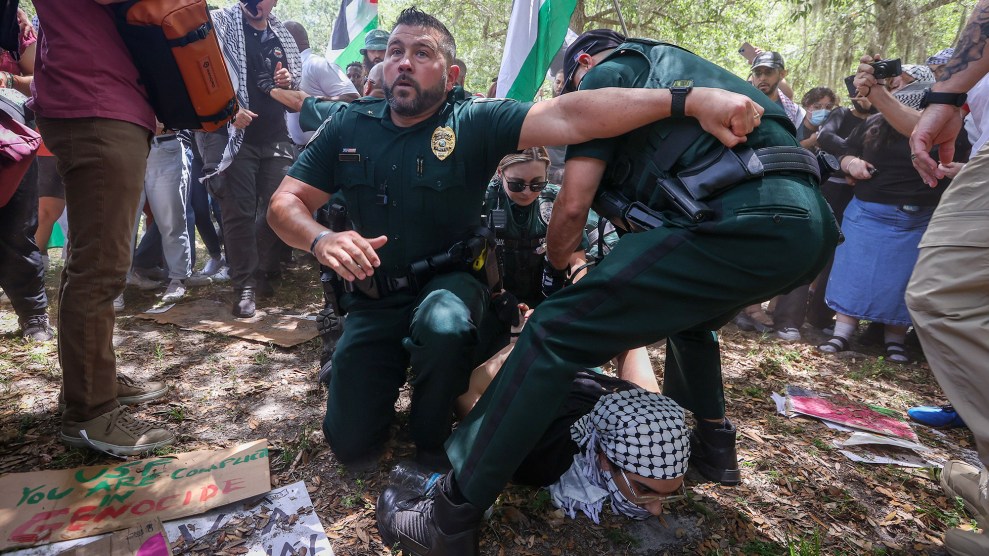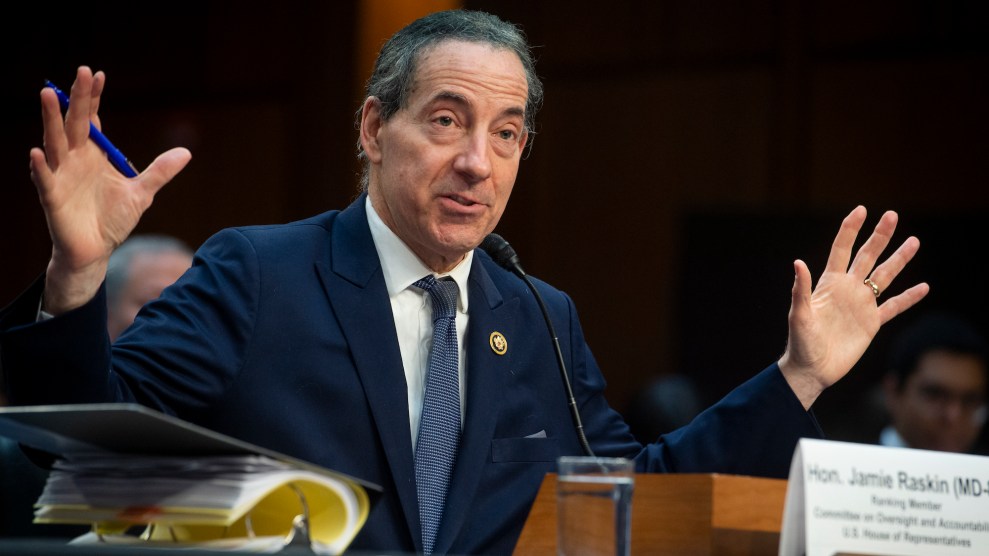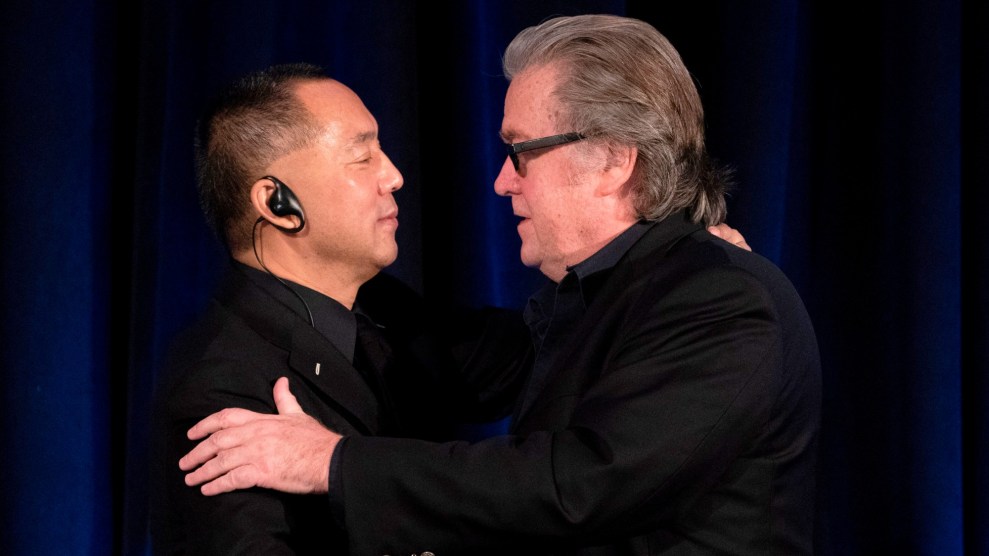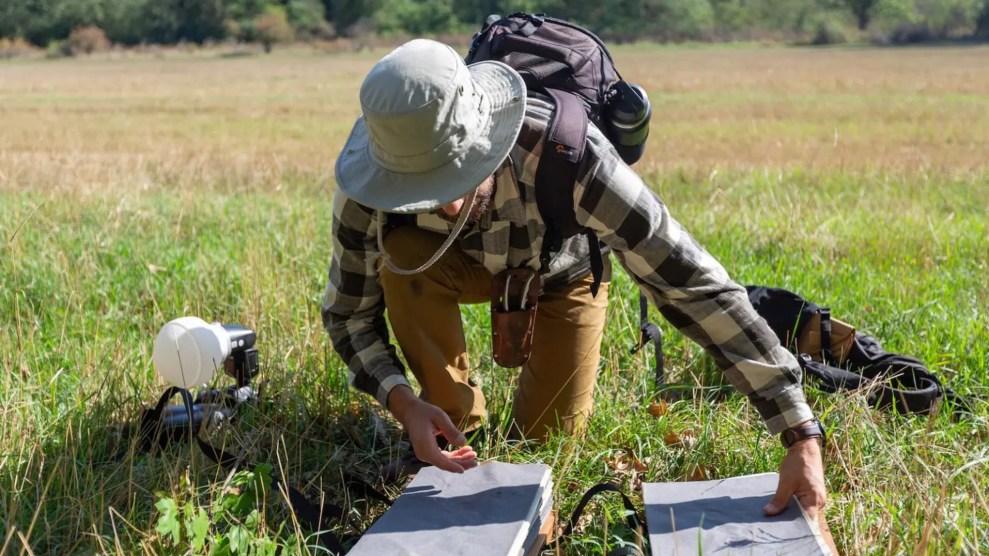That we are in a military quagmire in Iraq has become a fact of life among Americans of all political persuasions. Though Administration officials still sometimes speak of troop reductions in early 2006, and some top military men clearly no longer endorse “staying the course,” the muted voices of reason within the military and the State Department still talk in terms of a three-to-five year drawdown of forces followed by the “sustained presence of a large American contingent, perhaps 50,000 soldiers,” to be housed in the huge permanent bases the U.S. is continuing to construct and upgrade in Iraq. In addition, Gen. John P. Jumper, the Air Force Chief of Staff, recently told New York Times reporter Eric Schmitt that U.S. air power would be flying combat missions inside Iraq “more of less indefinitely.”
Many in the anti-war movement, despite the high-intensity moments generated by Camp Casey and Cindy Sheehan’s demand that President Bush at least meet with her “before another mother’s son dies in Iraq,” also seem increasingly resigned to a long-term military engagement with Iraq. While most continue to advocate the “immediate withdrawal” of American troops, such calls are uttered with little sense of hope. In fact, there appears to be a growing feeling that any form of “immediate” withdrawal will prove a thoroughly unsatisfactory option, destined only to intensify the present chaos in Iraq, trigger a civil war, and/or unleash a round of ethnic violence that could escalate to levels of near-genocidal mass murder. Instead, ever more critics of Bush’s Iraqi adventure are proposing “phased” withdrawal scenarios that could keep American troops at the ready for years to prevent the Iraqi pressure cooker from blowing its top.
Many of these cautious withdrawal scenarios are advocated by staunch opponents of the war. I am thinking, in particular, of Juan Cole, the most widely respected antiwar voice, and Robert Dreyfuss, a thoughtful critic of the war who publishes regularly at the independent website Tompaine.com as well as in the Nation and Mother Jones. Both have offered forceful warnings against a hasty American withdrawal, advocating instead that U.S. forces be pulled out in stages and only as the threat of civil war recedes. Dreyfuss expresses the thinking of many antiwar activists thusly:
“They worry that if the United States withdraws from Iraq, the result will be an all-out civil war among three major ethnic and religious blocs. (It’s facile to argue that Iraq is already wracked by civil war; yes, there is widespread terrorism, a guerrilla war against the U.S. occupation forces, and periodic clashes between Sunnis and Shiites. But it hasn’t reached anything like civil war proportions yet, and it might: Things could get far, far worse.) Maybe it’s too late for the United States to be able to do anything to prevent the outbreak of such a catastrophic civil conflict. But because there is so much at stake, it’s worth a try.”
Cole captures the same logic in a phrase: “All it would take would be for Sunni Arab guerrillas to assassinate Grand Ayatollah Sistani. And, boom”
And they are right. Black Wednesday, September 14, with its 12 Baghdad car bombs, killing at least 160 Iraqis, and wounding upward of 600, offered a flash of civil-war-level violence. Ordinarily, Iraqi-on-Iraqi violence accounts, on average, for fewer than 100 civilian deaths a week. This was true even during the car-bomb offensive just after the January elections. If a Black Wednesday occurred every week, the death toll from such violence might reach 15,000 per year, and we could start talking about a real civil war. So things could indeed get much worse.
But where Dreyfuss and Cole are mistaken is in concluding that U.S. forces can be part of an effort “to prevent the outbreak of such a catastrophic civil conflict.” Despite the plausible logic of this argument, the U.S. presence doesn’t deter, but contributes to, a thickening civil-war-like atmosphere in Iraq. It is always a dicey matter to project the present into the future, though that never stopped anybody from doing so. The future, by definition, is unknown and so open to the unexpected. Nonetheless, it is far more reasonable, based on what we now know, to assume that if the U.S. were to leave Iraq quickly, the level of violence would be reduced, possibly drastically, not heightened. Here are the four key reasons:
1. The U.S. military is already killing more civilian Iraqis than would likely die in any threatened civil war;
2. The U.S. presence is actually aggravating terrorist (Iraqi-on-Iraqi) violence, not suppressing it;
3. Much of the current terrorist violence would be likely to subside if the U.S. left;
4. The longer the U.S. stays, the more likely that scenarios involving an authentic civil war will prove accurate.
American Violence in Iraq
In listing the problems faced by Iraqis (“widespread terrorism, a guerrilla war against the U.S. occupation forces, and periodic clashes between Sunnis and Shiites.”), Dreyfuss is succumbing to the reportage of the mainstream press, which rarely mentions the immense toll that American forces are taking every day inside Iraq.
In fact, the best estimate is that the occupation has been killing about 40,000 Iraqi civilians each year. These figures were first published a year ago in a path-breaking, yet largely neglected, study published in the British medical journal the Lancet by a mixed team of researchers from Johns Hopkins University and Iraqi universities; but careful vetting of war reports indicates that something close to these rates seems to have been maintained ever since. That helps explain why even the distinctly limited numbers collected by U.S. and Iraqi official sources (when released at all) almost always report that American (or other) occupation forces account for at least two-thirds of all civilian deaths in military actions, with an unknown proportion of the remainder due to the actions of the Iraqi government, not the resistance.
There are four main ways American forces in Iraq accomplish such mayhem.
First, there are the hundreds of checkpoints around Baghdad and in other contested cities, sites of numerous violent incidents. Because of the danger created by the threat of suicide bombers, those guarding the checkpoints are ordered to fire at suspicious activity. The following account of the death of Reuters reporter Waleed Khaled, offered by Major-General Rick Lynch based on an official U.S. Army investigation, makes clear why even the most savvy Iraqi is risking his or her life approaching a checkpoint:
“Lynch said soldiers reacted when they saw the car traveling ?forward at a high rate of speed. That particular car looked like cars that we have seen in the past used as suicide bombs. It wasn’t a new car, it was an older model car… And there were two local nationals inside the car. Our soldiers took appropriate measures. We mourn the loss of life of all humans… But our soldiers are trained to respond in those situations. Put yourself in the place of the soldiers, knowing that the insurgents, who have been known to use suicide bombs, suicide car bombs, suicide vests, to attack innocent civilians, will always have an attack and then respond to that attack when the first responders come forward. So our soldiers took appropriate action on that particular case.'”
With some 600 checkpoints in Baghdad alone, and as many as 100 cars approaching each checkpoint during a non-curfew daylight hour, there are upwards of 250,000 chances each day for an Iraqi driver to fail to slow down soon enough, or, distracted, fail to see the checkpoint in time, or do something to make jumpy soldiers jump. If only one out of 40,000 drivers makes this mistake that still would produce perhaps 6 lethal incidents a day — in which case about 2,000 Iraqis would meet Waleed Khaled’s fate each year, although without the benefit of news coverage and a U.S. Army investigation, however perfunctory. (Note that, at this point, we have just about no way of knowing in any of the death situations discussed here and below how many Iraqis are dying, so these are the crudest of figures.)
Second, American troops are constantly patrolling contested areas in Iraqi cities under instructions to use “overwhelming force” in firefights with actual or suspected resistance fighters. If they encounter sustained resistance, the rules of engagement call for demolishing buildings occupied by snipers, and treating all inhabitants of such buildings as the enemy. Among the several hundred patrols or more each day around Iraq, it appears that about one in ten result in lethal firefights. Even if fewer than half of these firefights produce a single collateral civilian death, this tiny percentage would yield perhaps 15 deaths on an average day or close to 5,000 civilian deaths a year.
A third staple of the occupation is entering houses in search of suspected insurgents, either because they have been identified by informants, or as part of house-to-house searches after IED or other guerrilla attacks. U.S. statistics indicate that no fewer than 75% of all entered houses do not contain an insurgent, but the army rules of engagement require that soldiers enter without knocking and by crashing through doors in order to retain the element of surprise, and thus prevent either an ambush or an escape by suspects. Lethal force is used at the first sign of resistance or attempted escape –to preempt attacks with weapons that suspected insurgents might have hidden nearby. (The army argues that, while more humane treatment might create less anger among the tens of thousands of non-resistant families whose homes are invaded, such restraint would also expose the soldiers to many more casualties from the occasional resistance fighter. Military philosophy in this and other settings is to protect the lives of American soldiers “even if those methods do not always win the hearts and minds of the Iraqi populace.”)
With several hundred such missions undertaken each day, and such patrols entering as many as a dozen houses on a patrol, American troops enter something like 2,000 Iraqi homes on an ordinary day. If only one of every one hundred entries results in violence, and far less than half end in a dead civilian, these home invasions can still account for 10 or so deaths per day, or another 3,500 per year.
Fourth and finally, we come to American air power. When American patrols, large or small, encounter violent resistance, their rules of engagement call for the use of overwhelming fire power to eliminate the enemy. Where their immediate response fails to destroy the enemy, an air assault is often ordered, with either gunships or bombers. Air assaults are also ordered against suspected insurgent “safe houses.”
Although they are rarely reported, such air assaults are the most terrifying and ferocious forms of American violence. Virtually all of these strikes occur in highly populated areas, sometimes destroying whole houses, or even whole groups of houses, and (where the inhabitants haven’t fled) they sometimes kill whole families in the process. The New York Times recently reported such an attack in the border city of Husaybah, which “destroyed three houses in an area that has experienced intense fighting.” Unlike most such news items, this one also contained an Iraqi Interior Ministry report of casualties. Based on local hospital reports, the Ministry claimed that the air strikes “had killed more than 40 civilians, mostly members of an extended family who had sought shelter from the bombings.” (American officials, as is their general practice, said they “knew of no civilian casualties.”)
American officials do concede that they average about “50 close air support and armed reconnaissance missions every day.” These occur at all of the familiar urban hotspots: Baghdad, Falluja, Mosul, Tal Afar, Ramadi, Samarra, as well as numerous smaller towns. If only one in five of these missions produces civilian casualties, and if the average death toll is only four instead of 40, then 15,000 Iraqi civilians die every year from U.S. air attacks.
The depressing total of these very rough calculations is over 25,000 civilian deaths each year, more than five times the number caused by car bombs and other Iraqi-on-Iraqi violence. (And remember, we’re not even figuring in major American military campaigns against the insurgency.) To add to the levels of mayhem, keep in mind that, at any given moment, the U.S. military keeps perhaps another 12,000-15,000 Iraqis locked in its prisons, holding areas and interrogation centers. Numbers like this, or even lower versions of the same, explain why in a country with a population of only 25 million, so many Iraqis see the Americans as the main source of the daily violence they endure, and why 60% regularly tell even American-sponsored pollsters that they want an American withdrawal immediately, if not sooner. This also explains why the primary condition for a cease fire set by the Association of Muslim Scholars (AMS, the political arm of the Sunni resistance) was an American “troop pullout from most urban areas and an end to military checkpoints and raids.” AMS leader Isam al-Rawi explained:
“The Americans and British must leave all residential areas?This is very sensitive for our feelings. When they retreat to military bases outside the major cities, the Iraqis will no longer be meeting military tanks and trucks in the streets and highways, and they will no longer be afraid their homes will be invaded at night.”
Iraqi-on-Iraqi Violence
The prospect of a civil war is, of course, horrendous, but the ongoing American violence is massive enough that it would take several Bloody Wednesdays every week to match it. This, of course, is a possibility, but a more reasonable guess would be that, in a trade-off between the end of U.S. violence and an escalation in the civil war, the result would actually be a decline in civilian casualties in Iraq.
But a quick U.S. withdrawal would be less likely to produce a civil war than leaving American troops in place as a barrier against such a development. The killing and imprisonment policies of the occupation itself are the main generating and sustaining force for the rising levels of Iraqi-on-Iraqi violence. The sooner the occupation ends, the sooner Iraqi civil violence is likely to begin to subside.
To grasp this point, it is necessary to understand that there are — broadly speaking — two tendencies within the Sunni resistance against the U.S. occupation. While they share the goal of expelling the Americans, their strategies and tactics are fundamentally different. One tendency, which many Iraqis designate the “nationalist resistance,” seeks in the short run to expel the Americans from their local communities by attacking American patrols and checkpoints with roadside explosives and hit-and-run attacks. An operation is a success when it ties down American troops and therefore prevents them from manning checkpoints, marching through neighborhoods, or conducting house-to-house searches. While their attacks often kill innocent bystanders, they do not usually purposely target civilians, and often condemn those who do, calling them terrorists and outlaws.
The other tendency, designated the “jihadists” by many Iraqis, fights to weaken the resolve of the Americans and of Iraqis who, by their definition, help the occupation. For the jihadists, an operation is a success when it inflicts either a huge toll in casualties or scores a propaganda victory against the occupation or its supporters. Their tactics are designed to intimidate and demoralize their opposition. They therefore try to mount spectacular attacks on U.S. forces, the Iraqi military and police, Iraqi government officials, and also Iraqi civilians they feel are aiding the Americans, attempting to intimidate them away from voting in elections, participating in local government, or joining the police force or the new Iraqi military.
Beyond this immediate terrorist purpose, the leadership of the jihadists, most notably Abu Musab al Zarqawi, seeks sooner or later to create a mega-state among all Sunni Arabs in the Middle East. Zarqawi and others of his persuasion believe that Shiite Muslims are the main barrier to such a state and that, in the long run, they must be defeated. They therefore focus their terrorist attacks on the Shia, who, they believe, support the American-installed Iraqi government (rather than on the Kurds, who support that government far more avidly than any Shia group). In this way, the jihadist leadership hopes simultaneously to undermine Shia support for the American-sponsored government and to weaken the Shia in what they consider to be a larger, longer term confrontation.
Numerically, the jihadists represent a tiny minority of resistance fighters in Iraq (certainly no more than 10%). The vast majority (probably well over 90%) of the 70 or so attacks each day are conducted by the nationalist resistance. But the jihadists are responsible for the high-profile car bombings and the spectacular attacks against Shia mosques and other “soft targets.” These account for the vast majority of all the civilian casualties inflicted by the resistance.
Given this situation, how might a speedy American withdrawal affect the levels of Iraqi-generated violence? Most obviously, it would eliminate the presently predominant form of Iraqi violence — the 65 or so guerrilla attacks against American forces every day, (though many guerrilla units might redirect their attention to the Iraqi army, insofar as it chose to conduct American-type patrols in disputed neighborhoods). And it would also obviously eliminate the jihadist attacks against American troops and bases.
But those fearful of civil war worry that the American absence would remove the main deterrent to terrorist attacks and simply free-up jihadist resources from anti-American operations to unleash further mayhem. The full jihadist effort could then be concentrated on attacking the Shia.
Violence after an American Departure
What this assumption ignores, however, is a simple (though not obvious) fact: The terrorist offensive against the Shia is largely a consequence of American brutality in Iraq. Despite Abu Musab al Zarqawi’s oft repeated desire to launch a holy war against the Shia, his success in doing so is directly linked to a continuing U.S. presence. His primary appeal in Iraq, after all, rests on the claim that the occupation is “being aided by their allies from Shia.” Moreover, because, he claims, “the Shia sect has always spearheaded any war against Islam and Muslims throughout history,” he insists that they can never be brought into a movement to oppose the occupation and therefore have to be treated like the enemy. It is this appeal that, in Sunni areas, has allowed him to recruit supporters for his anti-Shia campaign.
University of Chicago political scientist Robert Pape, author of Dying to Win, the definitive book on suicide terrorism, spoke for virtually all terrorism experts, when he made this very point to the American Conservative magazine, asserting that every suicide bombing campaign “is driven by the presence of foreign forces on the territory that the terrorists view as their homeland. The [American ] operation in Iraq has stimulated suicide terrorism and has given suicide terrorism a new lease on life.”
Thus, while Zarqawi is seeking a holy war against the Shia, the real question — as Pape puts it — is whether “anybody listens to him.” In other words, his success depends on his ability to recruit new martyrs (inside and outside Iraq) to undertake suicide missions. This recruitment, in turn, depends upon two factors: the level of mayhem the occupation creates, which generates the anger that creates his volunteers; and the credibility of his claims that the Shia are allies of the Americans.
On both accounts, the military occupation of the country, by its very presence and its actions, continually pours more gasoline on an already burning fire, and cannot help but continue to do so as long as it attempts to pacify the resistance. After all, the daily mayhem in Baghdad and other cities, and the spectacular American assaults on cities like Falluja and Tal Afar, are broadcast across Iraq and the entire Muslim world (even if they are often largely ignored in the American media). These increase support for both the nationalist guerrillas and the jihadist terrorists.
In addition, under the strain of an exhausted army and a fractured budget, the Bush administration is seeking to “Iraqify” the occupation by replacing American troops with Iraqis. In 2004, after Sunni police and military units melted under fire or defected to the guerrillas, the U.S. began relying more heavily on Shia recruits (as well as Kurdish militiamen, or Pesh Merga) in their battles with the Sunni resistance. The brutality of the American military plan for pacifying the country, now being enacted by ever more Shia and Kurdish soldiers, has convinced increasing numbers of Sunnis that Zarqawi’s claims about the Shia are all too correct, and so has allowed him to recruit increasing numbers of willing martyrs, both in Iraq and in neighboring countries.
Just before Bloody Wednesday, at Tal Afar, Shia (as well as Pesh Merga) soldiers were given frontline responsibility for lethal house-to-house searches, spearheading the wholesale destruction of individual homes, many with residents still inside, and whole neighborhoods. It was no surprise, therefore, when, a few days later, Zarqawi declared that Bloody Wednesday was the beginning of the “battle to avenge the Sunni people of Tal Afar,” and also the beginning of a “full scale war on Shiites around Iraq, without mercy.” Here again, American action exacerbated rather than suppressed internal Iraqi friction.
This constant and escalating provocation only swells the reservoir of willing martyrs and increases the plausibility of Zarqawi’s claim that the sole route to “liberation” involves direct attacks on Shia citizens.
On the other hand, history indicates that once the provocation of foreign troops is removed, the reservoir tends to quickly drain. Terrorism expert Robert Pape reports that, in recent history, it is almost unknown for suicide bombings to continue after the withdrawal of the occupying power:
“Many people worry that once a large number of suicide terrorists have acted that it is impossible to wind it down. The history of the last 20 years, however, shows the opposite. Once the occupying forces withdraw from the homeland territory of the terrorists, they often stop–and often on a dime.”
American withdrawal is therefore the cornerstone of any strategy that wants to maximize the hope of avoiding civil war. It would, at one and the same moment, remove the major source of Iraqi civilian deaths — and remove the primary flash point that leads to the car bombings. It would certainly mean as well the withdrawal of Shia and Kurdish troops from Sunni cities — the key to Zarqawi’s ability to convince (some) Sunnis that the Shia are willing pawns of the occupation and so their eternal enemies.
The clock is ticking however. With each new American attack, more Sunnis are convinced that their hope for liberation lies with Zarqawi’s strategy. And with each new terrorist attack, Shia anger — already at a high level, given the degrading nature of the American occupation and two years of American-style “reconstruction” — is likely to become ever more focused on the Sunni community that appears to be harboring the terrorists. Recently there have been growing signs of violent Shia retaliation. If the terrorist attacks continue unabated, then increasing numbers of Shia may adopt an attitude complementary to Zarqawi’s — blaming the entire Sunni community for the terrorist attacks. If this occurs, Zarqawi will have succeeded in his personal goal of “dragging them into the arena of sectarian war,” and a raging civil war may truly develop.
Zarqawi’s plan will be in danger of collapsing, however, if the U.S. withdraws.
American withdrawal would undoubtedly leave a riven, impoverished Iraq, awash in a sea of weaponry, with problems galore, and numerous possibilities for future violence. The either/or of this situation may not be pretty, but on a grim landscape, a single reality stands out clearly: Not only is the American presence the main source of civilian casualties, it is also the primary contributor to the threat of civil war in Iraq. The longer we wait to withdraw, the worse the situation is likely to get — for the U.S. and for the Iraqis.
Michael Schwartz, Professor of Sociology at the State University of New York at Stony Brook has written extensively on popular protest and insurgency, and on American business and government dynamics. His work on Iraq has appeared on the internet at numerous sites, including Tomdispatch, Asia Times ,MotherJones.com, and ZNet; and in print at Contexts, Against the Current, and Z Magazine. His books include Radical Politics and Social Structure, The Power Structure of American Business (with Beth Mintz), and Social Policy and the Conservative Agenda (edited, with Clarence Lo). His email address is Ms42@optonline.net@optonline.net.
Copyright 2005 Michael Schwartz
This piece first appeared, with an introduction by Tom Engelhardt, at Tomdispatch.com.















